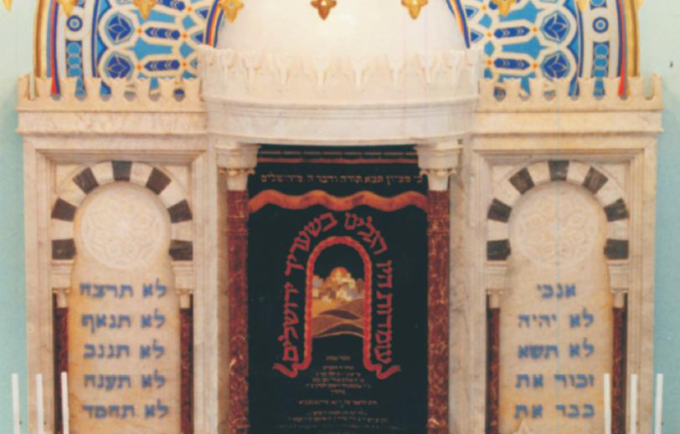The Peitav-Shul synagogue, located in Old Riga, on 6/8 Peitavas Street, is the only Riga synagogue, which has survived the Holocaust. It is also the only active synagogue in Riga and one of the two active synagogues in Latvia (the other one is located in Daugavpils).
In the late 19th century, a religious community, which united the Jews living in the area, was founded in the Old Town of Riga. The land plot for construction of the synagogue was purchased, and in March of 1903, a building permit was obtained.
An outstanding architect and art historian Wilhelm Neumann and an aspiring architect Hermann Seuberlich have created the design of the synagogue. The original concept of the structure has been changed several times; nevertheless, construction of the building was completed by the beginning of 1905. The synagogue was consecrated the same year.
The Peitav-Shul became one of the four Choral Synagogues of Riga. It was the second largest and the second most beautiful synagogue after the Great Choral Synagogue on Gogola Street – Gogol-Shul (which on the 4th of July 1941 was burned down by the Nazis and their local accomplices along with the people inside it; nowadays, a memorial and a monument to the rescuers of Jews during the Holocaust is situated at the place of the tragedy). In the area of liturgy, the Peitav-Shul has successfully competed with the Great Choral Synagogue. During the holidays, the synagogue was crowded, and those people were not only Jews, but also liturgical music lovers of other nationalities: synagogue choir under the direction of famous cantor Abraham Abramis was popular not only in the Jewish community.
After Riga was occupied by the Nazis on the 4th of July 1941, all synagogues of the city were burned down. The Peitav-Shul was the only one to escape this fate: because the building was located in the Old Town of Riga, the fire could spread to the adjoining houses. The synagogue building was used as a warehouse.
Later, when the Second World War was over, it has been discovered that the eastern wall of the synagogue, where a cabinet with the Torah scrolls (Aron Kodesh) was situated, remained intact. The salvage of scrolls is attributed to the priest of the nearby Reformed Church – Gustav Shaurums.
Worships in the Peitav-Shul were resumed after the war. In Soviet times, it was one of the few functioning synagogues in the Soviet Union and one of the four in which choir performances were held. Despite the unspoken prohibition of Jewish religious life and constant supervision by the state security authority, the synagogue remained the heart of the city’s Jewish life. Maintenance of the building and all the necessary repairs were carried out by the best effort of few religious community members.
In 1997, the state transferred the Choral Synagogue (Peitav-Shul) to the Riga Jewish religious community and the synagogue became the heart of Jewish religious life in Latvia. In 2007 and 2008, the synagogue building was fully renovated, thanks to the financial support of the European Union, government of the Republic of Latvia, Council of Jewish Communities of Latvia and donations from private investors.
Riga Peitav-Shul Choral Synagogue is one of the most beautiful houses of worship of the capital of Latvia. The building is an example of the art Nouveau, or Jugendstil, which was very common in Riga at the turn of the 19th and 20th centuries. The interior is decorated with ornaments featuring the elements of ancient Egyptian and Assyrian-Babylonian styles. Aron Kodesh (the Holy Ark), where the Torah scrolls are kept, is oriented towards Jerusalem. To the right from the entrance to the main hall, the names of the sponsors who subsidized construction of the building – Leib Lifshitz, Shraga Shapiro, Mordechai Michelson, Tsvi Kazhdan, Baruh Shlopobersky, Zalman Haikevich, Yitzhak Zaks, Abraham Blehman – are engraved on a marble plaque.











